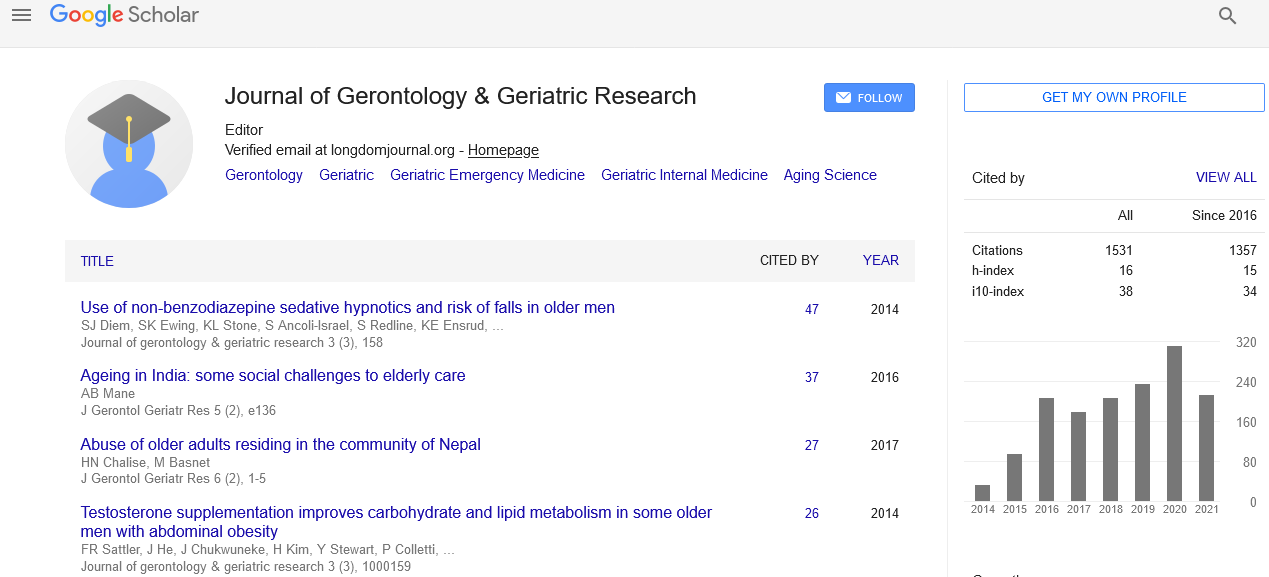PMC/PubMed Indexed Articles
Indexed In
- Open J Gate
- Genamics JournalSeek
- SafetyLit
- RefSeek
- Hamdard University
- EBSCO A-Z
- OCLC- WorldCat
- Publons
- Geneva Foundation for Medical Education and Research
- Euro Pub
- Google Scholar
Useful Links
Share This Page
Journal Flyer

Open Access Journals
- Agri and Aquaculture
- Biochemistry
- Bioinformatics & Systems Biology
- Business & Management
- Chemistry
- Clinical Sciences
- Engineering
- Food & Nutrition
- General Science
- Genetics & Molecular Biology
- Immunology & Microbiology
- Medical Sciences
- Neuroscience & Psychology
- Nursing & Health Care
- Pharmaceutical Sciences
The elderly microcirculation: Healthy and diseased
International Conference on Geriatrics & Gerontology
July 08-10, 2014 DoubleTree by Hilton Hotel Chicago-North Shore Conference Center, USA
Maggie S El-Nahid
Accepted Abstracts: J Gerontol Geriat Res
Abstract:
The interest in the study of the geriatric skin microcirculation rose from the hypothesis that skin microcirculatory changes mimic the changes in other vascular beds, including the cardiac. Several studies aimed to study the functional and structural changes in the skin microcirculation of the geriatric population. Controversies rose from whether the encountered changes were due to aging or due to associated diseases. We, therefore, aimed to study the skin microcirculation in a group of elderly subjects away from disease states known to affect the microcirculation as diabetes, hypertension and hypercholesterolemia. We also studied a group of elderly hypertensive patients. Both groups were compared to young healthy adults. Methods: The study population included 145 subjects, divided into three groups;Group A;50 healthy elderly subjects. Group B;60 elderly patients with long standing essential hypertension and Group C; 35 young healthy subjects. The microcirculation was assessed by means of the Laser Doppler Fluxmetry (LDF). The provocative test used, was the reactive hyperemia test (RH). Further evaluation of the apparent structural abnormalities in skin micro-vascular structure was done using the capilloroscope. Results: Results of the LDFshowed a statistically significant difference in the RH measurements between the normal geriatric group and the control group with no statistically significant difference in the capillary density by capillaroscopy. The hypertensive group revealed significant differences in the LDF measurements as well as the capillaroscope, compared to the control group. Conclusion: The study of the microcirculatory changes in normal geriatric subjects revealed the presence of functional microcirculatory abnormalities. This functional change is independent of any disease states. It is not accompanied by any evident structural changes.
Biography :
Maggie S El Nahid has completed her MD at the age of 35 years from Cairo University She is a nephrology specialist. She has worked for some time in the vascular lab of the internal medicine department where she finished several research projects, mostly published in local journals


